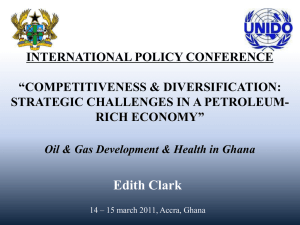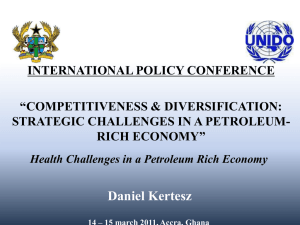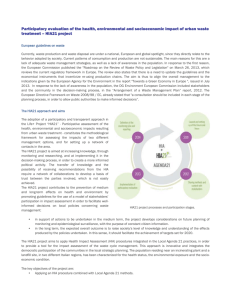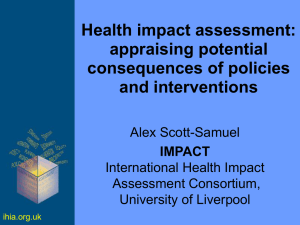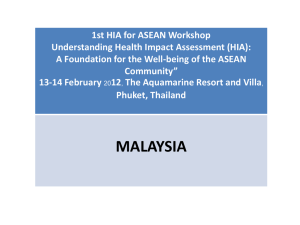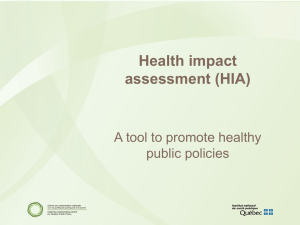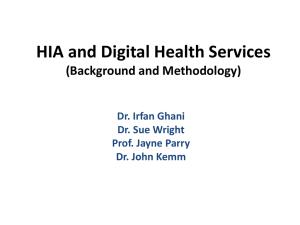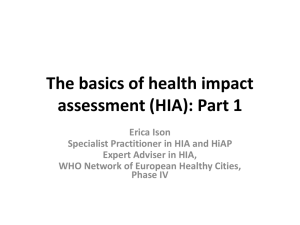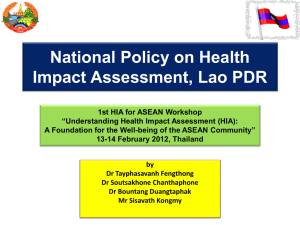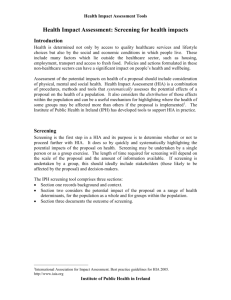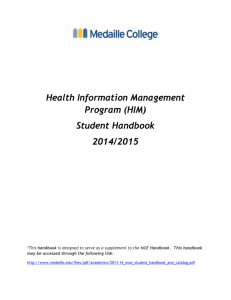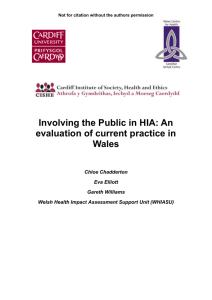Healthy Community Design/Mass in Motion RFP
advertisement
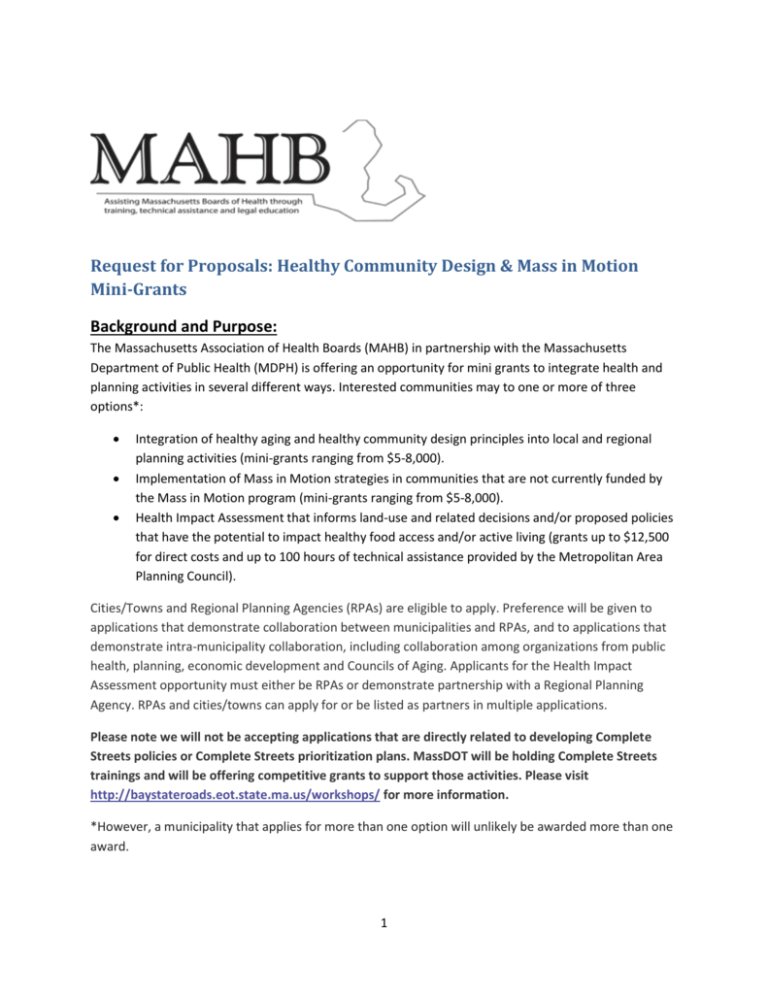
Request for Proposals: Healthy Community Design & Mass in Motion Mini-Grants Background and Purpose: The Massachusetts Association of Health Boards (MAHB) in partnership with the Massachusetts Department of Public Health (MDPH) is offering an opportunity for mini grants to integrate health and planning activities in several different ways. Interested communities may to one or more of three options*: Integration of healthy aging and healthy community design principles into local and regional planning activities (mini-grants ranging from $5-8,000). Implementation of Mass in Motion strategies in communities that are not currently funded by the Mass in Motion program (mini-grants ranging from $5-8,000). Health Impact Assessment that informs land-use and related decisions and/or proposed policies that have the potential to impact healthy food access and/or active living (grants up to $12,500 for direct costs and up to 100 hours of technical assistance provided by the Metropolitan Area Planning Council). Cities/Towns and Regional Planning Agencies (RPAs) are eligible to apply. Preference will be given to applications that demonstrate collaboration between municipalities and RPAs, and to applications that demonstrate intra-municipality collaboration, including collaboration among organizations from public health, planning, economic development and Councils of Aging. Applicants for the Health Impact Assessment opportunity must either be RPAs or demonstrate partnership with a Regional Planning Agency. RPAs and cities/towns can apply for or be listed as partners in multiple applications. Please note we will not be accepting applications that are directly related to developing Complete Streets policies or Complete Streets prioritization plans. MassDOT will be holding Complete Streets trainings and will be offering competitive grants to support those activities. Please visit http://baystateroads.eot.state.ma.us/workshops/ for more information. *However, a municipality that applies for more than one option will unlikely be awarded more than one award. 1 Healthy Aging through Healthy Community Design Healthy community design brings evidence-based strategies into community planning to facilitate healthy living. Municipal plans, policies, and regulations can have a profound impact on people’s ability to make healthy choices by shaping opportunities for physical activity and active living, affecting access to jobs and quality housing, and influencing access to healthy food. As we plan healthier communities, it is imperative that these policy and systems change strategies consider impacts on all residents and across the life span. This approach is embodied by the “8 to 80” concept: If you create a municipality that’s good for an 8-year old and good for an 80-year old, you will create a successful municipality for everyone. This is particularly important given the aging of communities across the state. Awards will range from approximately $5,000 to $8,000 per grantee and must be spent by June 30, 2016. Grantees must work towards implementation of healthy community design strategies aimed at creating conditions to support and reinforce healthy behaviors for people of all ages and abilities but particularly aimed at older adults. Projects must involve community visioning, planning, policy or regulatory change, or a combination of these activities. While walkability is a very important component of healthy community design, for these grants, projects related to improvements to existing public transportation infrastructure are not eligible (e.g. development of a Complete Streets Policy, or conducting a walk-audit to plan sidewalk or intersection improvements are not eligible). Projects that address the relationship between land-use patterns and walkability are eligible (e.g. zoning changes to allow mixed-use), as are policies and regulations that will shape future developments and site designs (e.g. changes to subdivision regulations, or site plan or special permit standards). Examples may include, but are not limited to the following: Zoning bylaw/ordinance changes or other regulatory reforms that will have positive impacts on older adults in a community (such as regulatory reforms that impact the diversity of housing types and locations); Policy development (such as piloting a snow removal ordinance); Initiatives that improve access to healthy and affordable food for seniors; Initiatives that improve access for older adults to safe physical activity spaces; Policies related to siting of municipal facilities—especially senior centers, libraries and other facilities used by older adults; A health-based review of municipal regulations that assesses barriers to active transportation, public transit access, access to healthy food and access to green/open space; Adding a healthy aging/healthy community design component to an existing community planning project such as development of a Master Plan or Open Space and Recreation Plan, a zoning revision effort, a District Local Technical Assistance (DLTA) project, a Unified Planning Work Program project or an anticipated MassWorks or other grant application; and Policy and systems planning to support movement towards “Age Friendly Cities” designation. Requirements: 2 Projects will be required to describe how they will use the Massachusetts Healthy Community Design Toolkit: Leveraging Positive Change in their projects design and implementation. The toolkit has specific information related to healthy community design and aging. You can access the toolkit at: http://www.pvpc.org/sites/default/files/HCDT_2ndEdition_140903.pdf o Technical assistance on the Toolkit will be made available to funded applicants through the Pioneer Valley Planning Commission on a negotiated and as-needed basis. Communities that are recipients of funds with synergistic activities (such as the Prevention and Wellness Trust Fund, bike/pedestrian safety projects through the Mass Highway Safety Plan, Mass in Motion, etc.) will need to demonstrate how new activities under this proposal would interact with those projects. This grant-funded project may not be used for programmatic strategies related to healthy aging (e.g. supporting chronic disease self-management programs). Applicants for these funds must describe how they will meaningfully engage older adult stakeholders in the project’s design and implementation. Preference for these funds will be given to applications demonstrating partnership between Regional Planning Agencies and city/town officials including planning, health and councils on aging. Projects involving multiple communities are eligible. Mass in Motion Strategies in Communities without Mass in Motion In alignment with the Mass in Motion Municipal Wellness and Leadership program, these mini-grants will increase opportunities for active living and healthy eating by creating conditions that support and reinforce healthy behaviors. Grantees will use the funds to transform where their residents live, work, play and go to school so that they can lead healthier, more productive lives. Interventions will focus on healthy eating, active living, and the promotion of healthy and safe physical environments. This particular funding stream is strictly for municipalities not currently receiving Mass in Motion funding from MDPH. This funding will provide approximately $5,000 to $8,000 that must be spent by June 30, 2016. Grantees must implement policy, systems and environmental change strategies aimed at creating conditions to support and reinforce healthy behaviors for people of all ages and abilities. Examples include, but are not limited to the following: Assess feasibility of improving small retail stores’ access to appropriate healthy food distribution networks; Develop a community food assessment plan to understand the local food landscape; Assess barriers to Supplemental Nutrition Assistance Program (SNAP) and Women, Infants, and Children (WIC) use at farmers’ markets and develop a plan to mitigate these barriers; Develop nutritional standards and guidelines for use at food pantries and meal sites; 3 Develop plan to increase access to plain water in municipally operated outdoor areas and facilities; Develop a plan to reduce advertising and marketing of calorie-dense, nutrient-poor foods and beverages near school grounds and public places frequently visited by youth; Develop a land use policy/zoning regulation to promote, expand, and protect potential sites for community gardens and farmers’ markets, such as vacant municipal-owned land or unused parking lots, particularly in underrepresented communities/neighborhoods; Develop and implement a joint use agreement to make community facilities available for recreational use by children, adults and families; Assess walking conditions around local schools, downtown districts and/or high crash locations and develop recommendations for improving the built environment to support safe and active transportation; Determine viability of a successful safe routes to school program based on students living within the school's walkshed and current student travel modes by implementing the http://masaferoutessurvey.org/en/; Develop health focused language (with measurable goals and objectives) to be inserted into municipal plans such as comprehensive/master plans, open space plans, etc.; Develop active design standards/guidelines for use with all new development projects; and Establish community protocols to assess the impact of built environment related changes on community health and well-being. Health Impact Assessment The goal for the health impact assessment (HIA) projects and technical assistance support is to increase the use of public health approaches, concepts, and data in municipally-led and/or regional planning projects. This includes projects such as village and downtown zoning studies, re-zonings, economic development studies, housing production plans, and corridor plans. Expected outcomes of this work are the integration of the HIA process into the local/regional planning projects (such as District Local Technical Assistance projects, Unified Planning Work Program projects and MassWorks applications) and demonstration of the HIA’s effect on project decision-making. Each funded project will use the HIA process as part of the overall project scope of work and include deliverables that demonstrate the HIA’s role in project decision-making. In formulating the HIA ideas the following should be considered: o There is a decision on a policy/plan related to the built environment that can be influenced by a HIA and that will add value to the decision-making process. o The decision is happening on a timeline that allows for the HIA to provide value to the decision-making process. o There are ways to meaningfully engage stakeholders (people who will be impacted by the decision and people who are making and/or influencing the decision). Requirements and other criteria: 4 HIA projects must be led by a Regional Planning Agency and/or demonstrate strong partnership with a Regional Planning Agency. In regions that have undergone the Planning Ahead for Growth priority mapping process, preference will be given to projects that are focused on designated Priority Development or Priority Preservation Areas. The HIA will follow the standard 6 steps of the HIA process and adhere to them. The HIA project will form an advisory committee or identify a set of project advisors to consult with during the project and will develop a stakeholder engagement plan. There will be a final report written which will include plans for reporting on the HIA’s findings and plans to track the impact of the HIA on the decision-making process. Funded projects will use the best available methods to measure bike/ped trips and bike/ped related injuries in the area on which the HIA is focused. Technical assistance from the Metropolitan Area Planning Council and from the MDPH will be provided and negotiated with selected projects. There will be a set number of hours of assistance. For more background information on Health Impact Assessments visit: www.healthimpactproject.org This funding will provide 3 grant awards of up to $12,500. The funding must be spent by July 30, 2016. Grantees must implement a rapid health impact assessment aimed at creating conditions to support and reinforce healthy behaviors for people of all ages and abilities. The grantees will also be able to receive up to 100 hours of additional TA support from MAPC and MDPH. Grantee Expectations: All grantees will be required to complete a final report on grant activities and outcomes as well as define steps to implement and sustain activities after the grant ends. Final reports are anticipated to be due in July 2016 (August 2016 for the HIA reports). MAHB, in coordination with MDPH, will conduct periodic check-ins with grantees to discuss grant progress, identify potential barriers and opportunities, and provide technical assistance and data support. Grantees will participate in short conferences/meetings to present on their activities to MDPH, MAHB and other interested parties. Opportunities for peer networking and sharing may also be scheduled. Application Instructions: Responses to this RFP should include the following and should not exceed 3 pages (not including the budget) 12-font: Contact Information: Name, address, telephone and e-mail; Brief description of proposed initiative, which of the three options under which it falls, and any experience your city or town has in implementing community-based healthy eating/active living activities; o For HIA applicants please focus on describing the decision that will be influenced (including timeline for the decision), who key decision-makers are and how the HIA will 5 involve them, tentative plans for community engagement, and how the HIA will add value to the decision making process. A short description of need in your community and explanation of how the proposed grant activities will address that need; A list of “key partners” you would engage upon receiving funding, the role you expect each partner to play, and any prior experience the lead agency has in working with these partners; A short work plan proposal (no more than ten milestone activities and corresponding dates) describing how you would implement proposed activities; Budget: Anticipated budget for proposed project with brief budget justification; o The budget period is 1/1/16-6/30/16 for the Healthy Aging through Healthy Community Design and Mass in Motion Strategies in Communities without Mass in Motion. o The budget period is 1/1/16-7/31/16 for the Health Impact Assessment projects. A letter of support from any municipal departments or agencies essential to implementing grant activities. Funds may be used for: Staff time Fringe Payroll taxes Program supplies In-state travel Contractual costs Administrative/overhead/indirect costs Utilities Community Engagement and Promotional Materials Funds may not be used for: Food expenses outside of food for meetings Equipment (ex. computers, laptops, cell phones, furniture, construction equipment, playground equipment, gym equipment, etc.) Gift cards/coupons/vouchers Litigation and/or for directly or indirectly participating in, or intervening in, any political campaign on behalf of (or in opposition to) any candidate for elective public office Supplanting existing public funding Support for programmatic /direct service activities such as health education or recreational programs 6 Application Deadline and/or Questions: The application is due on January 6th, 2016 by 5:00 pm. Email an electronic version of the application (in PDF or Microsoft Word format) to Cheryl Sbarra of MAHB at sbarra@mahb.org. Questions are welcome; please e-mail or call Cheryl Sbarra at (781) 721-0183. Award Announcements are anticipated to be made by January 15, 2016. 7
